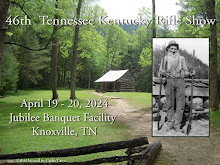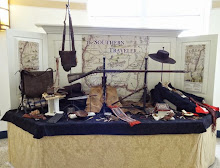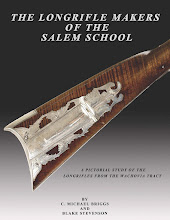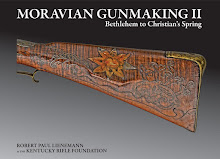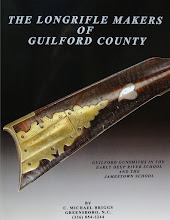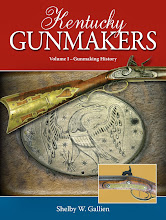The possession
of mechanical novelties during the 16th century was seen as
prestigious and there was perhaps nothing more esteemed than the
firearms produced for the ruling elite of Europe. Henry VIIIs
breech-loading wheellocks are amongst the best known of these firearms. Emperor
Charles V of Spain's Armoury which has been preserved at the Royal
Palace, Madrid, includes multi-shot and multi-barrelled wheellock guns of great
complexity and intrigue. No expense was spared in his quest for magnificent
arms and as Holy Roman Emperor he could choose from the best gunmakers of
Europe, including Germany, a country renowned for its mechanical inventions.
Gunmakers all over Europe were eager to prove their skill and ingenuity in
order to obtain the patronage of the ruling elite. The Kings
and nobility of Europe were equally keen to own something that
their rivals did not have. It is questionable just how functional these
weapons were, but at the time their very existence, and ownership of
them was to show to others, ominous power, great wealth and
possession of the latest fashion.
This was the envious
position that the Dukes of Savoy found themselves in when they engaged the
services of gunmakers, Jacques and Simon Robert. In the 1570s the Roberts’ were
able to make a relatively simple, easy to use and fast firing flintlock, at a
time when the alternative firearms were either the archaic matchlock, or the complex
and fragile wheellock. The few surviving firearms attributed to the Roberts’ bear
witness to a remarkable and quite unique form of flintlock that they had designed
and made available to their powerful patrons. This article looks at one example
of their work, which is now in the firearms collection at the Pitt Rivers
Museum, Oxford.
Savoy was a
small kingdom, formed in the 11th century, which occupied a region
of present day south-eastern France and north-west Italy. During the 16th century it was ruled by a succession of Dukes, notably Emmanuel
Philibert from 1553 until 1580, and then his son Charles Emmanuel I from 1580
until 1630. Both were accomplished military men, Emmanuel having made a name
for himself fighting the French while serving under the leadership of the Holy
Roman Emperor Charles V, where he gained the nickname “Ironhead”. Emmanuel l’s
son, Charles, succeeded on the death of his father in 1580. An ambitious and
self-confident man, Charles earned himself the nickname “Head of Fire” for his
military rashness and attitude.
Savoy was a
country under constant threat from its neighbours. It had been occupied by the
French since 1536 and it was Duke Emmanuel who finally drove them out in 1559. Once
Emmanuel had rid his country of the French, a supply of arms and armour for
defending it became paramount. In 1563 the Duke moved his court to the
centrally situated city of Turin. Among the many craftsmen working for him was
the gunmaker, Jacques Robert.
The State
Archives in Turin keep the records for the House of Savoy, including all the
financial transactions made by the ruling Dukes and importantly those relating
to the gunmakers’ Robert. Jacques Robert
is first mentioned in 1561 when the Treasurer of Duke Emmanuel was ordered to
pay the sum of 80 florins for guns made for him. By 1567 the accounts also record
a Simon Robert being paid for work carried out in the previous year. The accounts also reveal that the Roberts’
came from Franche-Comte, part of the Burgundy region of France, bordering
Switzerland and north of the areas of Lorraine and Alsace, the latter countries
being renowned for their gunmaking in the 16th and 17th century. A subsequent entry records that Jacques was the son of Simon Robert.
In 1575 the
Palace accounts record a payment made “to
Simon Robert, of one hundred livre for……the guns and snaphances (archibugi
et fucili) supplied by him”.
In Italy the
term fucile was used as early as the
14th century to describe a fire-steel or strike-a-light – in other
words a piece of steel used with a flint to produce sparks. By the third
quarter of the 16th century it was being applied to a gun lock that
replicated mechanically the action of striking a flint against a piece of steel
to produce sparks. A record of the use of this term at such an early date is
rare, as the snaphance lock (fucile),
the earliest known form of flint-using gun lock, only pre-dates this period by
about 30 years. The Roberts’ were evidently capable of producing a “state of
the art” gun lock that could be kept primed and then fired instantly in two
quick movements. Additionally it could be reloaded, primed and fired again in
quick succession. When compared to the two alternative gun lock mechanisms of
the day, the matchlock and the wheellock, the snaphance is seen as far superior.
The matchlock,
although simple in its construction, required very careful handling. Its
smouldering match cord dangled precariously around the power pan and needed to
be kept burning until it was used to fire the gun.
The wheellock,
both complex and expensive, a delicate mechanism of levers and springs and very
liable to malfunction, needed to be wound up for each shot. It was essential
that the winding spanner was not lost or broken and that there was enough left
of the pyrites, which was very prone to crumbling, to generate a spark.
While both these
mechanisms would work well in the right conditions, they were laborious to use
and their use in both war and hunting were potentially lethal to the user.
Only eight
firearms have so far been identified and attributed to the Roberts’. One of
them, the subject of this article, is a short snaphance lock gun of fine quality
that is now on display at the Pitt Rivers Museum, Oxford (PR.IV.69). It was
once the property of the grand-daddy of modern gun collectors, Samuel Rush Meyrick
(1783-1848) and a drawing of the lock is shown in Skelton’s Engraved Illustrations of Ancient Armour
published in 1830. It is thought that this musket was acquired by Pitt Rivers
in the early 1850s as part of his interest in the development of new firearms
and his work for the School of Musketry.
The gun is 144.7cm
(57 inches) in length, its plain octagonal iron barrel is 107.8cm (42½ inches)
and has a calibre of approx 17mm (16 bore). It has a brass blade front sight and
a V-shape standing back sight and the breech is inset with a makers’ mark, a
brass cartouche with the initial J. The same mark appears on the lockplate between
the pan and steel spring.
The wooden full-stock
is almost straight in form, reflecting the influence of German wheellock guns
of the period. It is inlaid overall with engraved bone, representing foliage, flowers
and birds linked by tendrils.
On the left side
of the butt is a large inlaid panel of bone surrounded by smaller pieces, which
are shaped and engraved and may represent an heraldic crest or coat of arms. It
is now considerably worn and so it is difficult to understand its meaning .
Unfortunately over the years some damage has been sustained to the delicate
stock and its inlays and areas of missing inlay and wood have subsequently been
filled. A long angular iron guard protects the trigger.
Although snaphance locks were known from the 1550s,
their use and production in Europe seems to have been spasmodic. While the
first mention of the mechanism appears in documents dating to 1547, the
earliest surviving snaphance dates to the 1550s and seems to be either North
German or Swedish in origin. From the late 1560s the snaphance lock was also being produced in
Scotland and subsequently in England where it enjoyed particular popularity
until the second quarter of the 17th century. In mainland Europe the history of the lock and
production remains vague and only a very few examples from the 16th century have survived. This suggests that its production there was limited and that the wheellock and matchlock
remained the dominant gun lock used until at least the 1620s.
The Robert
snaphance lock is quite unique and unusual, both in its form and operation. The
lock would almost certainly have been regarded as something quite special at
the time it was made, although only a few people in Savoy or the surrounding
area would have had the privilege of seeing one.
The robustly
constructed cock is quite distinctive, being short and straight with a baluster
neck. The long cock jaws are set at right angles to this and have a prominent
winged jaw-screw which is inserted upwards through the lower jaw. The oblong
shaped steel with a serrated striking face is also robustly constructed.
An unusual
feature of the lock is the pancover mechanism. A separate pancover, formed with
an integral arm, pivots in an arc, and is mounted on the outside of the
lockplate. This is activated by an externally mounted single leaf spring. A
rocking lever or bar, also spring activated is mounted on the outside of the
plate and hooks around the front of the pancover arm to keep it in place and
the pancover shut. The rocker bar is activated by the movement of the cock. As
the cock moves forward under pressure from the mainspring, a stud on its base depresses
the rear end of the bar, moving the front end slightly outwards and releasing
the pancover arm, thus exposing the pan.
Internally, the
lock is quite simple and consists of a powerful V-shaped mainspring acting on a
tumbler, which is held at full cock by a 2-piece sear. While the mainspring and
2-piece sear are not remarkable and could be found on any wheellock mechanism
of the day, the tumbler was unique. It is disc-shaped, formed with an integral squared
shank that protrudes through the lockplate and onto which is mounted the cock, that
is in turn held by a cross-pin. A section of the circumference of the tumbler is
notched and the toe of the mainspring fits into this. The disc-shaped tumbler is cut with a step or
ledge across its surface and the primary sear drops into this step to hold the
tumbler at full-cock - see below.
There is no
half-cock or safety position on the tumbler, although the steel can be moved
away from the pan, thereby ensuring an effective safety position. The Robert
lock has just 5 internal moving parts compared to an average of 20 internal
parts for a contemporary wheel lock.
Drawing showing
the tumbler (red) primary and secondary sears (yellow & blue) and
mainspring and sear spring (green)
Only three other
examples of the peculiar form of snaphance described above are known to exist. These
consist of two pistols, one of which is now at the Royal Armouries, Leeds
(XII-736) and the other in the Musee de l’Armee, Paris (M.1763), and a gun
which was restocked at a later date and was formerly in the William Renwick
collection (Sotheby’s sale 19 March 1973 – Lot 38; present whereabouts unknown).
Royal Armouries,
Leeds (XII-736)
Musee de l'Armee, Paris (M.1763)
How
do we know the snaphance lock described here is one of those made by the
Roberts’? The answer to this can be found in a portrait of Filippo of Savoy,
Prince of Piedmont (1586-1605) which shows him aged about 5 years. He was the
eldest son of Duke Carlo Emmanuel and the portrait is believed to have been
painted in about 1590. In his right hand he holds a miniature gun with a
snaphance lock which is clearly of the same type discussed above. The detail of
the lock mechanism is stunning and precise and even shows the sickle-shaped
wings of the cock jaws and the pancover release arm on the outside of the
lockplate. The lock is so similar to the Oxford gun that it can only be the
work of the Roberts’, and confirms beyond any doubt the link between the
Roberts’, their snaphance locks and the Dukes of Savoy. The portrait by artist
Jan Kraek and detail of the gun is shown below (Prado Museum, Madrid - No.1264).
Portrait of
Filippo of Savoy, Prince of Piedmont (1586-1605) by Jan Kraek - Prado Museum,
Madrid (No.1264)
Both the barrel
and the lockplate of the subject gun have a brass shield-shaped makers’ mark
containing the initial J, with two cross-bars at the top. This mark has been
found on four other guns, all wheellocks, three being of the French-type
wheellock, with a separate mainspring housed in the stock, and the fourth of
the more conventional German construction, with the mainspring mounted on the
lock plate.
Despite being
wheellocks, the stocks show such similarities to the subject gun and to the gun
shown in the portrait mentioned above, that they must have been made by the
same hand. Also, it is considered that, as these firearms display such strong
German and French gunmaking characteristics, they must have been made by
gunmakers from the regions of Lorraine or Burgundy, the area from where the
Roberts’ originated.
It appears that
Duke Carlo Emmanuel gave some of the wheellock guns made by the Roberts’ to the
Duke of Parma or another member of the Farnese family, as three are now in the
collection at the Capodimonte Palace, Naples.
In 1585 the
Palace accounts record that “the sum of
78 scudi be given to Jacques Robert, master gunmaker to His Highness, for the
remainder of the entire payment for 50 snaphances for guns which he has made
for the arquebusiers of the bodyguard of His Highness…”
Speculation
surrounds four further snaphance guns that might be connected with the Roberts.
These each have curious combined snaphance and matchlock mechanisms. Although
the locks differ in shape and quality, they nevertheless have several features
in common with those of the subject lock described above, in particular the
curious rocking pancover release bar that is mounted on the outside of the
lockplate. As far as it is known, this feature has not been found on any other
snaphance firearms from the 16th century. Is it possible that these
four snaphance locks are part of the fifty supplied by the Roberts in 1585?
Internally these
locks have a 2-piece sear that does not engage a ledge or step cut across the
tumbler as the subject lock does, but instead engages a hole cut into the flat
surface of the tumbler. This is similar in many respects to the engagement of
the sear and wheel of a wheellock. The muskets, of which three are in German
museums and the other in the Tojhusmuseet, Copenhagen, are variously dated
either 1571 or 1572 on their barrels, conveniently placing them within the
right time frame. Two are illustrated in Howard Blackmore’s, “Guns & Rifles of the World”, London
1965. At present and until further research is undertaken, we can only hypothesize
that these muskets were part of the original fifty made for the Dukes
bodyguard.
Tojhusmuseet, Copenhagen
Bavarian Army Museum, Germany
Veste Coburg
Castle, Germany
Despite giving some
the Robert wheellocks away, Duke Carlo Emmanuel seems to have kept the Roberts
and in particular their unique snaphance firearms, very much to himself.
Although Emmanuel was involved in various military actions during the 1580s and
1590s, there are no records suggesting that he armed either himself or his
troops with snaphance firearms to fight these campaigns. It seems that the
highly prized snaphances were kept securely within the Court and for the use of
his personnel bodyguards alone. To those within the Court and to Court
visitors, these guns would have been seen as something quite extraordinary. The
fact that his bodyguards carried firearms with such a fast firing mechanism
would undoubtedly provide a powerful message to any who sought to oppose him.
Father and son,
Simon and Jacques Robert, worked for the Dukes of Savoy over a period of thirty
years and during that time produced not only guns but also other arms too. The
Palace accounts show that in the 1570s, for example, the Roberts set up a water-powered
tilt hammer and mill for grinding and that during the 1580s Simon had not only
supplied the Duke with firearms, but also corselets and helmets of black
armour. The unique snaphance firearms produced by the Roberts could be seen as
an extravagant sideline for the Dukes of Savoy to impress their Court and
visiting dignitaries, but also arming their bodyguards with these guns would be
perceived as a display of power and modernity.
It seems likely
that Simon Robert died while still in service to the Duke, as according to the
Palace accounts of 1595 his widow Joannine, received “36 ducats for payment to his heirs of the second quarter of the pension
assigned to him”. As for Jacques nothing else is recorded in the Palace
accounts or is known about him. His unique snaphance lock appears to have
slipped into obscurity and apart from the examples mentioned no other records
or Robert snaphances are known.
Roberts’
masterpiece can be seen in the Upper Gallery of the Pitt Rivers Museum, Oxford.
Acknowledgements
This article has
drawn heavily on the work of the late Claude Blair, who researched the Robert
gunmakers and published his findings in the Italian arms collecting bulletin
Armi Antiche in 1988 under the title, “Simon
and Jacques Robert and some early snaphance locks”.
In the
production of this article the author would like to acknowledge the kind
assistance of Jeremy Coote, Helen Hales, Elin Bornemann from the Pitt Rivers
Museum, and also to Bob Freeman for his help with the photography.



























